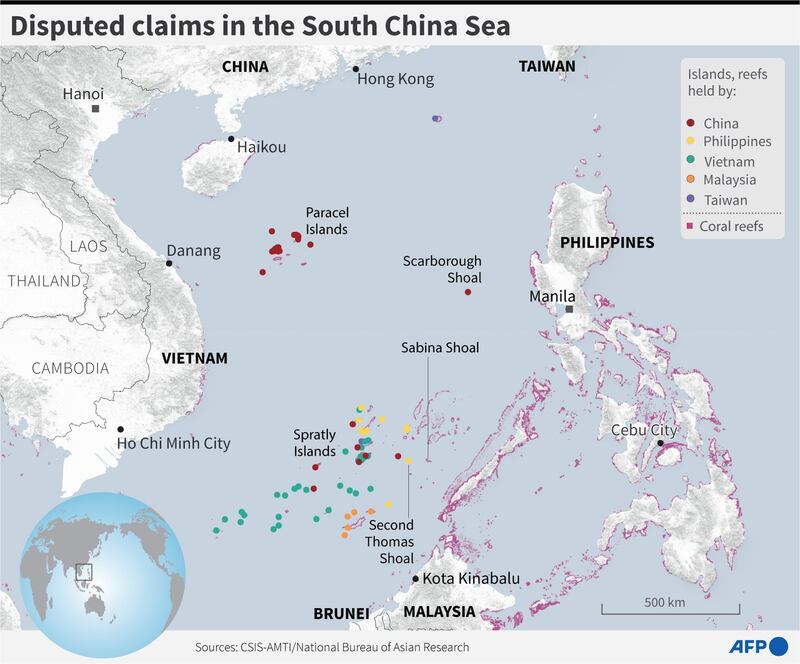Filipino officials tried to reassure the Philippine public Monday that they had not surrendered Manila’s claim of sovereign rights over Sabina Shoal to China by withdrawing a coast guard ship from the disputed reef.
The Philippine Coast Guard said it pulled its ship out from the shoal’s waters over the weekend and sent it back to port because crew members needed medical care and repairs had to be done to the BRP Teresa Magbanua after a five-month deployment.
Because of alleged harassment by Chinese ships at Sabina Shoal , the Philippine crew had to ration their food supply and eat rice porridge for weeks, a coast guard spokesman said.
“We did not surrender [the Sabina Shoal]. It’s wrong to say we surrendered it,” said Commodore Jay Tarriela, the coast guard’s spokesman on the West Philippine Sea (South China Sea), in defending the coast guard’s move.
The Coast Guard plans to dispatch a ship back to Sabina Shoal as soon as possible in order to guard the South China Sea reef that lies within Manila’s exclusive economic zone, he said.
“The Philippine Coast Guard, together with the Armed Forces of the Philippines, will never abandon our sovereign rights over these waters,” he told a news conference.

Both China and the Philippines have contending claims over the shoal, located about 140 km (76 nautical miles) from the Philippine island of Palawan and about 1,200 km (648 nautical miles) from Hainan island, the nearest major Chinese landmass. The Philippines has sovereign rights to explore Sabina Shoal for natural resources because of its location within Manila’s 200-nautical mile EEZ.
China refers to Sabina Shoal as “Xianbin Jiao” and the Philippines calls it Escoda Shoal. For Manila, the reef serves as a rendezvous point for resupply missions to nearby Second Thomas Shoal (Ayungin Shoal), where the Philippines keeps a World War II-era ship to serve as a military outpost and territorial marker.
RELATED STORIES
[ Philippines says 200-plus Chinese vessels have clustered in its EEZOpens in new window ]
[ China, Philippines trade blame on collisions near contested South China Sea shoalOpens in new window ]
[ Chinese study: No evidence of widespread damage to corals at disputed reefOpens in new window ]
The Teresa Magbanua, one of the coast guard’s largest and most modern ships, was deployed to Sabina Shoal in April amid reports that China may be trying to reclaim land there. In response, Beijing accused Manila of “illegally grounding” the BRP Teresa Magbanua to “forcibly occupy” the shoal.
In August, Manila claimed that Beijing had harassed its vessels at least five times in waters near the shoal.
Tarriela declined to say if another vessel had been deployed or was about to be sent to replace the Teresa Magbanua at Sabina Shoal.
Since last month, the coast guard had difficulty resupplying the ship since due to alleged Chinese harassment in area waters, he said.
In addition to crew members having to eat rice porridge for weeks, the ship’s desalination machine also broke down, forcing them to drink rainwater, according to Tarriela.
“When there is no rain, they even have to gather water from their air-conditioning units. Then they’re just going to boil it and that will be used for drinking,” said Tarriela.
Following Manila’s pullout of the BRP Teresa Magbanua, Beijing’s coast guard said on Sunday that China had “indisputable sovereignty” over Sabina Shoal.
Shades of Scarborough Shoal?
Some analysts believe that the Sabina Shoal situation is similar to what happened at Scarborough Shoal.
The South China Sea atoll, approximately 222 km (120 nautical miles) west of the Philippine island of Luzon, is a rich fishing destination for Filipinos.
China took possession of the shoal in 2012, forcing the Philippines to file a lawsuit before a world court. Four years later, the Permanent Court of Arbitration in The Hague ruled in Manila’s favor and dismissed Beijing’s sweeping territorial claims over the South China Sea.
But Beijing has refused to acknowledge the ruling.

Defense and security analyst Sherwin Ona said the government “should maintain a strong presence [in Sabina Shoal] to avoid a repeat of 2012.”
China is engaged in attrition, Ona told BenarNews on Monday. “They’re severely damaging our ships to limit our operational capability. The de facto control of the [Sabina Shoal] is the main goal.”
“They know that our resources are limited. The ramming incidents [in August] show the intention to incapacitate our capital ships," said Ona, who teaches at Manila’s De La Salle University.
Security analyst Chester Cabalza, however, said it would be a mistake to describe the PCG’s action over the weekend as a retreat. It was necessary, he said, to allow tired coast guard personnel to “recharge.”
“If it’s a retreat for the Philippines, why would we dare to return?” said the analyst at International Development and Security Cooperation, a Manila think-tank, arguing that compared to 12 years ago, Manila could now read “Beijing’s art of deception.”
READ MORE
[ To guard against Chinese buildup, Philippines will not leave Sabina ShoalOpens in new window ]
[ Philippine coast guard rejects China’s ‘illegal stranding’ claimOpens in new window ]
[ Manila accuses Beijing of island building in South China SeaOpens in new window ]
BenarNews is an RFA-affiliated news outlet. Editor’s note: Addition to clarify headline
